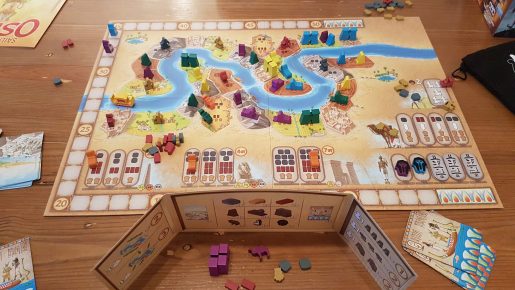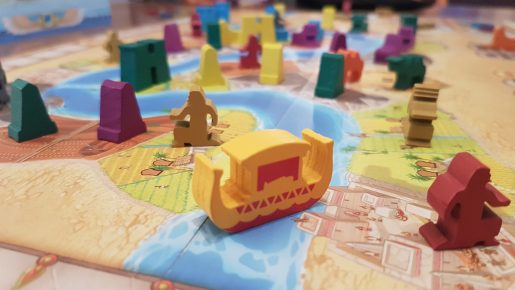Sailing Toward Osiris is an ancient Egyptian themed worker placement board game, which was released earlier this year (2018), by Daily Magic Games. Designed by W. David MacKenzie, with art from Denis Martynets, the game sees 2 – 5 players spend around 60 – 90 minutes (based on the player count) gathering resources, building grand monuments and negotiating. However, is Sailing Toward Osiris a title that is fit for the new Pharaoh? Let’s find out.
Each player, or governor, starts with 9 buildings (4 obelisks, 3 sphinxes and 2 pylons), they are also given a Withdraw token, a camel and their player marker is put on the point track. To give everyone a headstart players all get 2 of each resource type: Wheat, Brick and Stone. Randomly the starting player is chosen and they are referred to as the Regent.
There are four segments of the river for the Pharaoh’s barge to drift down, equally the game is played out over four rounds, or seasons. Players draw workers from a general pool, however the twist is that they are randomly drawn from a bag. The amount that each player draws, and how many are added to the labour pool, is dependent on the player count. You’ll have to check the rules each game as this isn’t denoted on the board.
On a turn players have a lot to choose from, with a whopping 10 available actions. Three actions refer directly to workers, playing them to harvest resources, onto a city for cards or onto a caravan. Caravan spaces on their own offer a decent recent return, though if you’re the first player to go you get to leave a camel. If the adjacent caravan action space is then used by another player they’d have to pay you, the camel owner, one of the obtained resources. Note, in a 2/3 player games one of the available caravan space blocked off, balancing them to the player count.
For harvesting there is an interesting rule when choosing worker placement spaces, that players cannot harvest on spaces ahead of the Pharaoh’s barge with basic workers, whilst master workers can go anywhere. This, in addition to the colour of the workers matching the resource types they can harvest, adds a lot of weight to drawing workers from the draw bag each round. The movement of the barge creates a board that grows over time, to combat the reduction in spaces due to constructed monuments. When choosing a space to go, each resource space has two halves. If both are free you can claim both at once, gaining all the resources on offer. If only one half is free, with the other half blocked by a monument, you just get the resources shown on that half.
Resources are going to help pay for other actions such as hiring additional workers from the cartouche, trading at the market and planning a monument. Both resources and workers are all finite in Sailing Toward Osiris, with spent resources not returning to a general pool for harvest purposes until the end of a round. This can see players hoarding at times, but with only limited time players will need to constantly churn through their available resources for best use of actions.
Monuments are what’ll win you the game so pouring resources into their construction is a simple aim. Players must pay the resources denoted by an empty build space on the board to first plan a monument, with spaces split into the three monument types. On a future turn before the end of that season the player must then move it to an unoccupied space along the Nile, unless playing the right boon card. Obelisks can be placed on any space that would generate 2 resources, sphinxes can go anywhere other than cities and pylons must either be placed on 3 resource spaces or cities. Due to their placement rules and with bonuses on offer at the end of the game building at the right time can be key. Each type gains players a different number of points, but generally also cost more, awarding 2, 4 and 7 points respectively (obelisks, sphinxes and pylons) .
There are two actions which revolve around cards. Redeeming a city card gives players two options: either receive the indicated resource on the upper left of the card or complete the action. Actions have situational benefits such as being able to build an obelisk where another obelisk is; therefore, it is nice to see the balance of always being able to redeem them for resources. It also opens up the opportunity for players to use a city card to reduce the pool of a resource type to zero before an opponent can get what they need. The issue with these cards are some powers are so situational that a game can be won by simply top-decking that perfect card.
Boon cards are one time abilities that each player has an identical set of. Each round a player can only play one boon card and it cannot match any of the already played boon cards from other players in that round. This sees players whom are eager to use a specific power use their boon card early in a round, limiting the options of others. The ability of the goddess Bastet to choose one of the left over workers from the draw bag for free has notably been a hotly contested power.
The final action is to withdraw from the season, with the first player to do so not only gaining a choice of resource based benefits but also becoming the Regent for the next round. Each season goes until all players have withdrawn. At the end of the season the selected withdraw bonus is covered, spent resources return to the general pool, the Pharaoh’s barge moves to the next river segment, the workers are put back into the the draw bag and played boon cards are discarded.
At any point in the game, outside of the regular actions, players can barter and make deals: even withdrawn players can take part in negotiations, though they still cannot perform actions. When it comes to what players can trade it is very much open, with resources, unused meeples, city cards and even future actions all allowed to be part of the deal. Note, that the promise of a future action is not enforceable, so you’ll have to just shame those whom go back on their word after the game is over.
At the end of the fourth and final season bonus points are awarded. For each set of 3 adjacent monuments 2 points are awarded and if you manage to get 4 monuments constructed on single river segment 3 points are earnt. This isn’t always as easy as it sounds with players able to block you. After bonuses, whomever has garnered the most glory for the old Pharaoh is crowned the winner, taking the role of the new Pharaoh.
Setup for a 4 – 5 player game is fairly swift, however this is not quite the case for 3 and lower. This is due to there being specific rules to change setup for a 3 player game, with additional caveats for a 2 player experience, that see spaces blocked. While it is great that the experience stays tight, there is the feeling of not getting to experience the full game with the quantity of spaces and cartouches blocked off.
As with any euro-style title conflict, and to some extent player interaction, is limited. Instead of blatant take that moves if players can work out others strategies they can disrupt them, via deploying workers or monuments. Some interaction can be instilled into the game if your group enjoys the bartering, it just so happens the players I’ve played with to date hardly utilized this mechanic and it is especially rare in a 2 player game. This creates a game with subtlety, with players attempting to not make it too obvious what they are going for.
Sailing Toward Osiris is draped with theme and top quality components, from a gorgeous board to the monuments players will construct. The barge is sailing down the iconic river Nile, which gets slowly adorned by obelisks, sphinxes and pylons, projects an illusion of grandeur and what westerners think of when thinking of ancient Egypt. The most incredible element is that the lore behind the game is somewhat real: with Ramesses XI actually passing on the throne to Smendes, as he had built the Pharaoh’s tomb. With this it is hard not to get excited as a fan of ancient Egyptian history.
There is no getting away from the fact that there are a lot of available actions to players. From an explanation point this can see new players stuck listening to rules, before getting into the game. The amount also means the game ends up above the entry level category which on the surface it looks perfect for. It isn’t that the game is overly complex but the number does daunt some players, while others will want for their first hobby game to just jump in and play. This is a bit of a shame as Sailing Toward Osiris can introduce new players to the likes of resource gathering and their importance, worker placement mechanics and open players eyes to a world of non-roll to move titles. The action list almost needs streamlining with the caravan action for example seeming more about shoehorning in camels due the setting than a valid improvement to the game.
Putting the awesome ancient Egyptian theme aside players are effectively building monuments for points, with resources. There isn’t much to break the game from this mould. Sitting just above the conventional stepping-stone category Sailing Toward Osiris is the sort of game I would get to the table with gamers that would be willing to learn, as it takes a game or two to properly grasp a good strategy. Alas, it’s just not light enough to be one of those titles that can instantly provide a “wow” experience for new gamers. At the other end of the gamer spectrum, for hobby gamers there is two major points of randomness, drawing from the bag and the city cards. With a bit of luck in both you can steal a victory but that doesn’t feel like you’ve truly earnt it. It is a shame that only with the right players, those looking for something a bit meaty whilst enjoying randomness, that the brilliant theme will allow Sailing Toward Osiris to return to the table. Simply, it won’t be brought down from the shelf much otherwise.
[Editor’s Note: Sailing Toward Osiris was provided to us by Asmodee UK for review purposes. The game is currently available from local UK board game stores, find your local store here]






